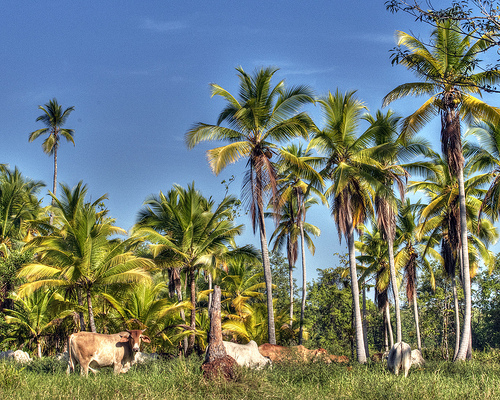Last week I discussed the genetics and biology of the rainforest and the importance of maintaining its diverse gene pool. Today, I’d like to go a little further into what causes deforestation.
What are the causes of this devastation? The four primary causes are 1) commercial logging, 2) fuel wood gathering, 3) cattle ranching, and 4) small scale forest farming and population pressure. The causes are complicated, since they are simultaneously political, psychological and economical. Many people claim that the rainforests must be developed and conquered to help the poor and landless. In some cases, settlement of civilians by the government is meant to secure national borders by establishing a presence in the frontier region.
Some tropical forests are increasingly exploited because more people want more wood. The consumption of wood is expected to increase dramatically during the last years of this century. Of the total, one-third of the wood will be used as fuel in developing countries. Over 50 percent will be used in developed countries, where demand has been rapidly growing for construction products like plywood, veneer and particle board.
In Brazil, cattle ranching and subsistence farming have been the largest contributor to deforestation. Until the 1970’s, the government sponsored a program that promoted colonization. The government gave ranchers incentives to exploit the rainforest and develop either farms or ranches. A large percentage of the clearing that took place was a result of various government incentives, but cattle ranching proved to be inefficient.
In many countries, meat production on a pound-per-acre basis is ten times what ranchers in Brazil will receive. Once the rainforest is cleared, the pasture or farm land has a life expectancy of less than eight years
Conservationists have, in the past, boycotted the fast-food industry, and many restaurants now swear that they no longer use Latin American beef. However, this can be difficult to prove. Combination meat products are difficult to trace because once imported beef is inspected, it’s allowed to enter the United States market without any requirement to show its country of origin.
Another factor contributing to deforestation is our booming world population. The largest percentage of this growth takes place in developing countries in rainforest regions. Small-scale forest (subsistence) farming, the search for fuel, and government programs to provide the landless poor with an opportunity to own property within the rainforest will, in the future, represent the largest threat to this ecosystem.
In the rainforest, the nutrients reside in the biomass, rather than the soil. The biomass is the total weight of all the organisms–plant and animal–in an area. The rainforest is so efficient and utilizes all of the nutrients so quickly that it’s always in the process of transformation. Therefore, very few nutrients can be found in the rainforest soil. When a rainforest is burned, carbon is released as ash and briefly acts as a nutrient or fertilizer, allowing crops to grow. But as soon as this ash is used up, the soil becomes barren.
While the causes of the decline in rainforests are complicated, the role that rainforests serve in the global balance of nature is quite simple. As a gene bank, the rainforest, by supplying that genetic diversity, directly and indirectly protects all of the plants and animals on the globe, including the human population. These forests provide habitat for countless plant and animal species and they store massive amounts of carbon which in turn, helps in the fight against global warming.
Studies have shown that the rainforest can produce natural products whose value far outweighs agricultural or ranching products. The economic worth of these rainforests for purposes other than ranching and farming is significant and should be recognized.
If the present patterns continue, all or most of the world’s remaining rainforest will be lost or severely degraded by the end of this century. When the trees are cleared away, little except scrub grass and weeds will grow in the poor soil. When plants and animals that used these trees for cover are exposed and die, the formerly lush forest will be replaced with a desert. This desert area tends to grow larger and creates a very dangerous spiral: with fewer trees, less vapor rises into the atmosphere, which causes less rainfall that in turn destroys more rainforest, and on and on.
Recognizing the above, it’s clear that preserving this belt of rainforest along the equator is one of the most important environmental stands that conservationists can take. The political implications of success here are as important as the biological consequences. If, through long-term sustainable development, environmentalists worldwide can influence the preservation of this fragile ecosystem, they will have won a battle of global significance.
What are some actions that we as individuals can take? Here are a few ideas to get started:
- We can also avoid eating fast food products that come from rainforest countries. We need to read the label that specifies the country of origin of all food products.
- We can avoid purchasing or using tropical wood products, and we can promote a local boycott of these products.
- We can lobby our political representatives to support policies that reduce debt and promote sustainable management of resources in developing countries. These policies should tie aid in developing countries to environmentally appropriate land use and energy policy.
As consumers, we all place a demand on the market that the market will attempt to meet. Our demand acts as the driving force behind what we consume and produce. We must quickly become aware of that relationship and learn to harness this potential. Consumers must demand that producers provide alternative products.
The problems in America and other developed countries are linked to issues of too much, rather than too little. The ecology movement must become more linked to economic problems and less to ideology. I believe that ecological ideology has in general ignored the context of economic development from which the problems of pollution have been generated. We must bring the two closer together.

